We sincerely hope that you greatly enjoy this article about 6 Breathtaking Raptors. This kind of bird often evokes many powerful emotions, such as awe and wonder, and for good reasons. In these creatures, Nature created a fabulous blend of beauty, grace, and power. Of course, these 6 represent only a tiny handful of the more than 500 species of raptors around the world. But, we hope these 6 Breathtaking Raptors serve to awaken in you a hunger to know more.
Harpy Eagle
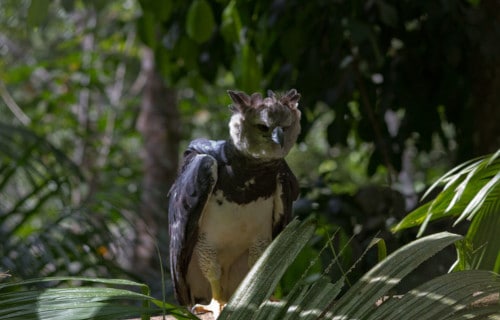
CCL: https://bit.ly/30qYpIs
Harpy Eagle Facts
- The first entry into this article about 6 Breathtaking Raptors is the marvelous species known as the Harpy Eagle.
- Most notably, the magnificent eagle ranks as the largest and most powerful of all known types of eagles living in a rainforest. Furthermore, this truly stunning variety of raptor also ranks as one of the largest species of eagle found anywhere on earth.
- Some confusion does surround the animal, however, in regards to its common name. Some individuals refer to it as the American harpy eagle. This occurs due to the desire to avoid confusing it with another species of eagle inhabiting the same habitat range.
- Quite unfortunately, the IUCN now lists this incredible bird as Near Threatened, on its Red List of Threatened Species. This lamentable fact occurs due to a combination of factors. Chief among these remains the ongoing severe destruction of much of its natural habitat.
- In fact, in parts of the range it previously inhabited, the gorgeous animal has now disappeared entirely. In addition to this, the magnificent bird known as the Harpy Eagle also faces various other threats to its continued existence.
- Even in the regions it still appears in, its numbers appear to be reduced. Finally, it also faces the same dire threat as many other species around the world today. This consists of the ongoing threat of climate change, which looms over countless species.
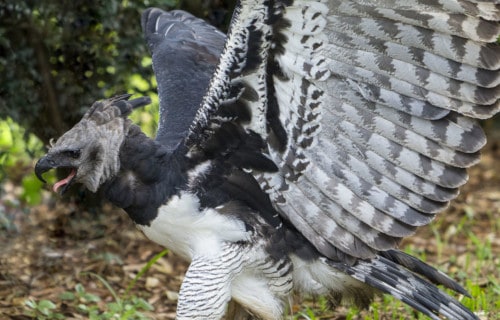
CCL: https://bit.ly/2R08atS
Harpy Eagle Physical Description
The truly stunning Harpy Eagle possesses an extremely visually striking physical appearance. This truly sets it apart from related species. This statement holds true for several reasons. Its sheer physical size only represents one of these factors, however.
But, as remains true of many species, this bird displays the trait of sexual dimorphism. In its case, however, this means that the female reaches a significantly greater size than her male counterpart. Also, both genders have the largest talons of any type of eagle.
Firstly, the female of the marvelous species, being the larger of the two, typically attains a maximum body length measuring about 3.5 ft (1.07 m). Meanwhile, the smaller male of the species pales in comparison. He rarely exceeds a body length of 2 ft 10 in (86.5 cm).
Secondly, the females further attain a much greater mass than the males. The body weight of the female achieves an average totaling as much as 18. 3 lb (8.3 kg). Yet the males, however, only reach a maximum known weight of 13.1 lb (5.95 kg), and average much less.
However, both genders of the Harpy Eagle do share many characteristics. This includes displaying the same overall physical appearance. The upper portions of the body present dark black feathers. Yet, the underside of the bird remains primarily white in color.
The exception to this tendency is that of the presence of thin black stripes on each of its legs. But, the remarkably majestic head displays a pale gray color, along with a double crest. Finally, the upper side of the tail shows a black color, with three gray stripes.
- Kingdom: Animala
- Phylum: Chordata
- Class: Aves
- Order: Accipitriformes
- Family: Accipitridae
- Genus: Harpia
- Species: H. harpyja
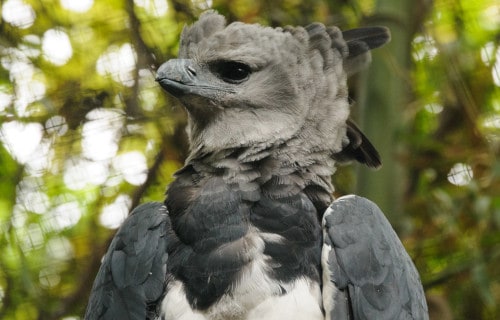
CCL: https://bit.ly/2yxhcYQ
Harpy Eagle Distribution, Habitat, and Ecology
Technically, the native habitat range of the magnificent Harpy Eagle measures quite extensive. In point of fact, it extends from Mexico, in North America, to Argentina, in South America. However, in the country of Mexico, the fabulous creature appears to be nearly extinct.
But very sadly, this marvelous bird continues to have a thinly scattered population. Furthermore, this lamentable fact holds true throughout the entirety of its known range. The loss of much of its native habitat negatively impacts it as much as other species.
In addition, the animal has a very specific type of region in which it makes its home. The majestic predator primarily inhabits regions of lush tropical rainforests. Not surprisingly, the majority of its numbers appear in this habitat in the country of Brazil.
Furthermore, it also requires a particular range of height above sea level for its range. Most individuals live in areas with an elevation lower than 3,000 ft (900 m). Yet, scattered individuals do appear at altitudes of as much as 6,600 ft (2,000 m), in areas of similar vegetation.
The powerful Harpy Eagle remains one of the top predators in every area it lives in. Furthermore, its prey mainly consists of various tree-dwelling mammals. Yet, it also occasionally hunts such animals as squirrels, porcupines, and opossums, to name a few.
More precisely, however, sloths and monkeys comprise the majority of its food supply. In this respect, its great size and power provide it with a significant advantage. Meanwhile, the deadly creature itself understandably has very few natural predators.
Long Eared Owl
Long Eared Owl Facts
- Next up on our list of 6 Breathtaking Raptors comes the amazing species known as the Long Eared Owl.
- Perhaps most notably, the descriptive term of Long Eared Owl serves as one of the common names for a truly majestic type of raptor. However, the animal also possesses several other common names. These are used in various parts of its range.
- These alternate common names include several highly descriptive terms. They include such terms as the cat owl, the lesser horned owl, and the northern long-eared owl. However, this beautiful avian also goes by the scientific name of Asio otus.
- Furthermore, this truly gorgeous creature also shares a great portion of its native range with a related avian. That’s the visually quite similar species known as the short-eared owl. The two animal can most easily be distinguished while at rest.
- That’s because, at that time, the ear tufts of the Long Eared Owl become clearly visible. This constitutes the most easily recognizable physical difference between the two. In addition, the eyes of the two different creatures display different colors.
- Additionally, a total of four recognized subspecies of this remarkable avian currently exist. But, the Long Eared Owl has a decided advantage over many of them. Unlike some of them, this wonderful bird appears to have a sizable and stable population.
- Due to this, the IUCN presently lists it as a Species of Least Concern. This ranking appears on its Red List. Nevertheless, it must be considered to be facing at least a few threats to its existence. These would include habitat loss and climate change.
Long Eared Owl Physical Description
Firstly, the beautiful Long Eared Owl merits attention for other factors than merely its size. That holds true because the animal develops as an owl of medium physical size. Secondly, it does display a moderate of the characteristic of sexual dimorphism.
Further, individuals of this animal attain a respectable body size. Mature specimens average roughly 16 in (40 cm) in total length. Meanwhile, wingspans average about 39 in (100 cm). In addition, adult body weight varies, but averages 15.3 oz (435 g).
In addition, the female of the stunning Long Eared Owl also grows larger and heavier than the male. Yet, she also develops as darker in coloring. Further, the prominent ear tufts of both sexes generally develop as black in color, and centered on the head.
Also, the prominent feathers of the bird possess a striking pattern of colors. These usually appear as a light brown in color, with vertical darker stripes present as well. Finally, the impressive eyes of this stunning species also grow comparatively large.
- Kingdom: Animalia
- Phylum: Chordata
- Class: Aves
- Order: Strigiformes
- Family: Strigidae
- Genus: Asio
- Species: A. otus
Long Eared Owl Distribution, Habitat, and Ecology
Much like many related species the Long Eared Owl evolved as partially migratory in nature. However, to the surprise of many people, this avian inhabits a relatively broad swathe of the globe. That’s due to the fact that it appears on three separate continents.
More precisely, however, it appears in a total of three separate continents. These consist of the continents of Asia, Europe, and North America. Furthermore, the fascinating animal commonly moves southward within its native range during the winter months.
In addition, the stunning raptor also has decided preferences for the type of region it chooses for its habitat. This holds true since individuals primarily inhabit forests that developed close to open areas. This further provides a combination of protective cover and good hunting.
In addition, most individuals typically make nests in coniferous trees. Also, breeding occurs between February and July, and clutches average 4-6 eggs. Further, the marvelous Long Eared Owl shares one particular behavioral characteristic common to all owls.
That’s the fact that it generally hunts at night. Even among its kindred, this animal stands out for its skill as a hunter. The raptor remains renowned for being virtually silent while hunting. Its principal prey consists of a variety of small mammals, rodents, and other birds.
Bald Eagle
Bald Eagle Facts
- Placing third among these choices of 6 Breathtaking Raptors, though only due to random selection, comes the magnificent Bald Eagle.
- Firstly, the term serves as the common name for an incredibly majestic bird that technically classifies as a sea eagle. Further, this magnificent avian also goes by the difficult to pronounce scientific name of the Haliaeetus leucocephalus.
- By either name, however, this animal currently remains the only known variety of sea eagle native to the its particular portion of the world. In addition, science currently recognizes two known subspecies of this incredible bird still in existence.
- Somewhat ironically, despite its now quite famous name, the breathtaking animal isn’t actually bald at all. This misconception occurs because the name derives from a much older term. That original term actually means white-headed.
- Furthermore, and most fortunately, the population of the stunning Bald Eagle appears to be sufficient and stable. That condition, while precarious, holds true, at least for the moment. This fortunate situation was not always the case, however.
- In the past, the breathtaking raptor nearly became extinct, before protective measures were implemented. Thankfully, though, it now holds the status of Least Concern with the IUCN. However, it still faces the threat of climate change.

CCL: https://bit.ly/1p2b8Ke
Bald Eagle Physical Description
Most notably, the gorgeous Bald Eagle displays the physiological characteristic of sexual dimorphism. That remains a characteristic shared by many of its related species, though. In its case, however, this trait presents itself as a matter of size.
That holds true due to the fact that the females of the species average about 25% larger than the males. Furthermore, these larger females weigh as much as 14 lb (6.3 kg). In addition to this, exceptional females sometimes even attain a wingspan of 7.5 ft (2.3 m).
Also, the gorgeous plumage of the creature continues to be one of its most striking features. This trait presents as a distinctive combination of dark brown on the body, and white on the head and tail. That combination has served to make it one of the most recognizable birds on earth.
Further, the eyes, beak, and feet of the majestic Bald Eagle show a bright yellow in color. The talons also develop large and razor-sharp, as with most raptors. In addition, the Bald Eagle possesses the ability to retract its talons at will, but rarely chooses to do so.
- Kingdom: Animalia
- Phylum: Chordata
- Class: Aves
- Order: Accipitriformes
- Family: Accipitridae
- Genus: Haliaetus
- Species: H. leucocephalus
Bald Eagle Distribution, Habitat, and Ecology
The range of the Bald Eagle thankfully remains quite extensive in nature. The beautiful creature inhabits most of North America. This extends from northern Mexico, to all of the continental United States. It also inhabits temperate portions of Alaska, and most of the country of Canada.
Quite fortunately, this particular avian possesses a decided advantage over some competitors. It quickly proved itself to be highly adaptable to a variety of habitat types. Due to this trait, it can, and often does, live in bayous, deciduous forests, and even the Sonoran Desert.
Furthermore, the beautiful animal holds yet another distinction. It generally prefers to build its large nests in the tops of the tallest trees near a body of water. In fact, the amazing avian holds the distinction of building the largest nest of any bird in its range.
Further, in point of fact, these hold a place in the record books. Its constructions remain the largest arboreal nests of any known animal. These may be as much as 13 ft (4 m) deep, 8.2 ft (2.5 m) wide. Quite amazingly, each can also weigh up to 2,000 lb (907 kg).
Much like related species, the fabulous Bald Eagle evolved to feed entirely as a carnivore. It also feeds opportunistically, consuming a wide variety of prey. But, the majority of the prey of most individuals remains comprised of numerous types of locally available fish.
Finally, it remains fascinating for one more reason. Individuals of this species also typically mate for life. Additionally, when offspring arrive, both parents care for the young, unlike some birds. Finally, this breathtaking bird can live up to 20 years in the wild.
Snowy Owl
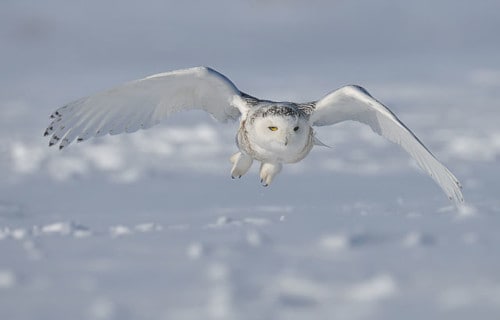
CCL: http://bit.ly/2REt4fw
Snowy Owl Facts
- Our next selection to appear in this compendium of 6 Breathtaking Raptors is the fabulous Snowy Owl.
- Firstly, the truly magnificent raptor ranks as comparatively large, in relation other species of owl. This remarkable fact occurs despite the relative harshness of its native habitat. The magnificent animal further remains easily recognized for its distinctive features.
- The gorgeous animal also goes by the scientific name of Bubo scandiacus Regardless of the term used, this amazing bird also stands out for its sheer physical size. This holds true due to the fact that the animal constitutes one of the largest known species of owl.
- In addition, on average, individuals also commonly rank as the heaviest owl species, as well. This impressive statistic only serves to further enhance its sheer awesomeness. Sadly, though, the Snowy Owl ranks as Vulnerable, on the IUCN Red List.
- Finally, the animal also possesses numerous evolutionary adaptations. These most notably include such factors as relatively thick plumage, heavily feathered feet with claws, and distinctive color patterns. These render it well-adapted for life north of the Arctic Circle.
Snowy Owl Physical Description
Perhaps most notably, the eyes of the Snowy Owl provide an incredibly striking visual appeal. In point of fact, these most commonly display a brilliant shade of yellow. This distinctive feature contrasts quite sharply with the black beak and white feathers the bird also possesses.
The bird also displays a moderate degree of the trait of sexual dimorphism. Most adult males appear virtually pure white, but females and young birds have some dark markings. A young member of the species also appears heavily barred, and dark spotting may even predominate.
The beautiful Snowy Owl achieves some impressive measurements. That holds true due to the fact that mature adults sometimes reaches a body length of as much as 28 in (71 cm). Further, its wingspan may be up to 59 in (150 cm). Finally, individuals may weigh almost 6.6 lb (3 kg).
- Kingdom: Animalia
- Phylum: Chordata
- Class: Aves
- Order: Strigiformes
- Family: Strigidae
- Genus: Bubo
- Species: B. scandiacus
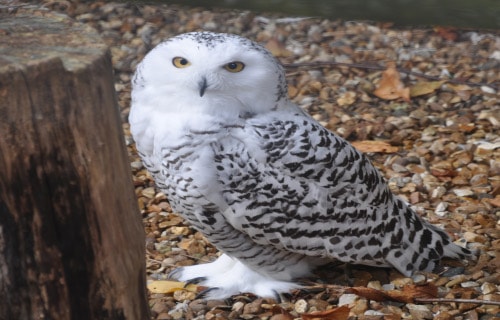
CCL: http://bit.ly/2xQPH8p
Snowy Owl Distribution, Habitat, and Ecology
The truly beautiful Snowy Owl nests in the Arctic tundra of the northernmost stretches of Alaska and Canada, in North America, and also Eurasia. Most also winter south through Canada and northern Eurasia, with a presence occurring further south in some years.
Most of the birds like open areas like coastal dunes and prairies that appear somewhat similar to tundra. The animals have been reported as far south as the American states of Texas, Georgia, the American Gulf states, southernmost Russia, and northern China.
The owl remains a very powerful animal for its size. It primarily preys on lemmings and other small rodents for food during the breeding season. However, at times of low prey density, or during the nesting period, it may switch to favoring juvenile ptarmigan.
The incredible birds also evolved as primarily opportunistic hunters. In addition, typical prey species vary considerably, especially in winter. Furthermore, it feeds on a wide variety of small mammals such as meadow voles and deer mice.
The Snowy Owl takes advantage of larger prey as well. Some of the larger mammal prey includes hares, muskrats, marmots, squirrels, rabbits, raccoons, prairie dogs, rats, moles, and smaller birds.
The owl will also take fish from the surface of lakes. Each bird must capture roughly 7 -12 mice per day to meet its food requirement and can eat more than 1,600 lemmings per year. Like many other birds, the bird swallows its prey whole.
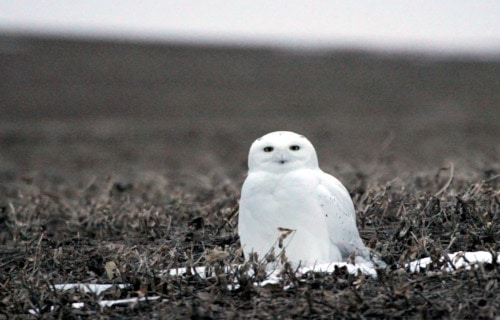
CCL: http://bit.ly/2xQPH8p
Snowy Owl Threats
Though Snowy Owls have few predators, the adults remain very watchful at all times. Further, the mature individuals have been blessed by Nature for self-protection. This holds true since each comes equipped to defend against any kind of threat towards them or their offspring.
During the nesting season, the impressive owls regularly defend the nests against any and all potential threats. These dangers include such predators as arctic foxes, corvids, and swift-flying jaegers. Other threats, however, include dogs, gray wolves and avian predators.
In addition, the males of the remarkably adapted species defend the nest. Consequently, these often act much like human sentries. This they accomplish by standing guard nearby, while the female incubates the vulnerable eggs and broods the young.
Additionally, both sexes of the awesome Snowy Owl readily attack approaching predators. This often occurs with great ferocity. This the animals accomplish by dive-bombing them and engaging in distraction displays to draw the predator away from a nest.
Crowned Eagle
Crowned Eagle Facts
- The fifth entry into this compilation about 6 Breathtaking Raptors is the startling animal known as the Crowned Eagle.
- Firstly, the distinctive, not to mention regal, appearance of the bird makes this majestic animal easily recognizable. But the fabulous species of avian also goes by the alternate common names of the crowned hawk-eagle and the African crowned eagle.
- Its scientific name remains the difficult to pronounce Stephanoaetus coronatus. The Swedish zoologist Carl Linnaeus became the first person to officially recognize the species. This occurred in the year 1766, along with the assigning of an official name.
- This species also remains known for a particular behavioral characteristic. This occurs specifically due to its extremely skittish behavior, even compared to related species. But, the species also has a reputation for being an exceptionally powerful raptor.
- Sadly, however, the IUCN currently lists the stunning Crowned Eagle as Near Threatened. That ranking appears on the organization’s Red List. Quite sadly, it occurs because experts estimate that fewer than 1,500 members of this species remain extant.
- Quite unfortunately, like many other creatures, it faces the threat of imminent extinction. Also like many others, the primary threat that it faces appears to be habitat loss. Nevertheless, though, various other factors also add to its precarious situation.
Crowned Eagle Physical Description
Most notably, in terms of length, the Crowned Eagle constitutes a highly impressive creature. This further holds true even when compared to other raptors. That remains true due to the fact that the bird ranks as the fifth largest known variety of eagle on earth.
Also, like many related species, the magnificent creature displays a moderate degree of the physiological characteristic of sexual dimorphism. Due to this, the female averages about 15% larger than the male. Some individuals measure as much as 39 in (99 cm) in length.
Further, particularly exceptional individuals sometimes weigh up to 10.5 lb (4.7 kg). Meanwhile, wingspan can be almost 6 ft (1.83 m). In addition, the talons grow exceptionally large and powerful. These often measure as much as 4 in (10 cm) long.
Additionally, its coloring evolved in an especially impressive pattern. This pattern typically consists of a mottled combination of brown, black, white, and gray, as mature adults. However, infants typically display white and black, with traces of pink on the chests.
Finally, the head of the gorgeous Crowned Eagle further serves to distinguish it among its peers. To be more precise, the head of the magnificent avian develops topped with a distinctive crest. This provides it with a highly distinctive triangular appearance.
- Kingdom: Animalia
- Phylum: Chordata
- Class: Aves
- Order: Accipitriformes
- Family: Accipitridae
- Genus: Stephanoaetus
- Species: S. coronatus
Crowned Eagle Distribution, Habitat, and Ecology
The Crowned Eagle evolved as endemic to a moderately large portion of the globe. This magnificent bird presently inhabits a wide swathe of Africa. In point of fact, scattered individuals occur in small numbers across a range that extends from the country of Ethiopia to Angola.
This remarkable avian possesses a decided preference for certain regions. It primarily inhabits dense forests, including the African rainforest regions. The bird has, however, proven itself to be adaptable to other regions when necessary. Some reside at altitudes of as much as 9,800 ft (3,000 m).
Further, like all eagles, the powerful predator naturally has an entirely carnivorous nature. To be more precise, it primarily preys on mammals, and in fact, fills a unique niche. Furthermore, it represents the only known variety of avian to prey mostly on primates.
Because of this, smaller species of monkeys comprise roughly 90% of its diet. But, it also doesn’t shy away from larger prey. This holds true since the astounding Crowned Eagle also sometimes preys on animals weighing as much as five times its own weight.
Thankfully, steps have now been taken to assist in the survival of the amazing animal. Quite fortunately,the species now has legal protection throughout most of its habitat range. However, and most unfortunately, its numbers continue to diminish.
The distinctive raptor also evolved specific patterns pertaining to mating. Firstly, it typically reproduces every two years. Secondly, it usually builds its nests high in the local tree canopy. Thirdly, much like other species, both genders typically share in caring for the eggs and raising the young.
Black-and-white hawk-eagle
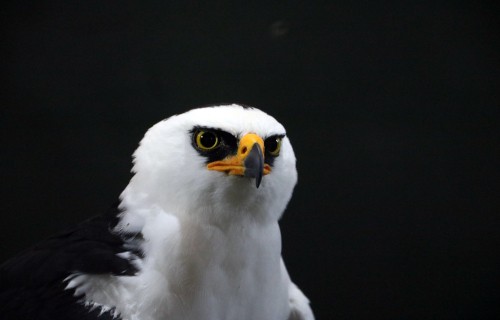
CCL: https://bit.ly/2VfqAZV
Black-and-white hawk-eagle Facts
- The final bird among these selections for inclusion in this article about 6 Breathtaking Raptors is the Black-and-white hawk-eagle.
- First of all, the distinctive name of the beautiful bird serves as the common name of a visually remarkable avian species. However, this magnificent bird also bears the somewhat cumbersome scientific name of the Spizaetus melanoleucus.
- The noted French ornithologist Louis Jean Pierre Vieillot holds the distinction of many firsts. Among these is the fact that he represented the first scientist to officially describe the species. Further, this fortuitous action occurred in the year 1816.
- Unfortunately, despite its numbers and range, a sad fact remains. In point of fact, researchers still know very little about certain aspects of the life of this bird. Further, this lack of information holds especially true in regards to its breeding habits.
- The visually striking creature represents a source of some confusion in scientific circles. This holds true due to a most uncommon set of circumstances. That consists of the fact that it has been moved from one genus to another several times.
- For the moment, the IUCN lists the Black-and-white hawk-eagle as Least Concern. This listing appears in its Red List of Threatened Species. However, that status could easily change in the near future, as conditions appear to be changing rapidly.
- For one thing, its population numbers currently appear to be diminishing. This situation also, lamentably, extends throughout the entirety its natural range. In addition, though, the effects of ongoing climate change likely form its greatest threat.
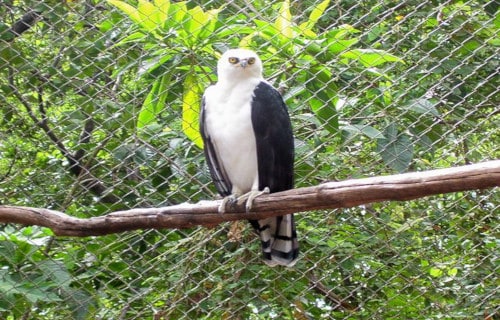
CCL: https://bit.ly/3bhmS7v
Black-and-white hawk-eagle Physical Description
The gorgeous Black-and-white hawk-eagle merits attention for more than just its size. In point of fact, the bird ranks as a moderate-sized raptor. Further, like many related species, this animal displays a moderate degree of the physiological trait of sexual dimorphism.
In the case of this particular creature, this characteristic manifests itself in the fact that some females attain a slightly larger average weight. The species as a whole develops respectable measurements. Firstly, adults reach an average body length of about 20 – 24 in (50 – 60 cm).
Secondly, a typical wingspan for both genders equates to roughly 46 in (117 cm). Thirdly, though weight remains where the genders differ slightly, overall averages remain approximately equal. To be precise, a typical weight equals roughly 1.88 lb (0.85 kg).
In terms of appearance, however, no gender-based differences appear. In point of fact, both sexes of the remarkable Black-and-white hawk-eagle remain virtually indistinguishable. Further, as the common name suggests, the basic color scheme is black and white.
Additionally, this pattern of colors generally presents itself with the body, neck, and head being white in color. In addition, the wings display a dark black, along with a lone black spot on the top of the head. But the tail shows brown with dark gray.
- Kingdom: Animalia
- Phylum: Chordata
- Class: Aves
- Order: Accipitriformes
- Family: Accipitridae
- Genus: Spizaetus
- Species: S. melanoleucus
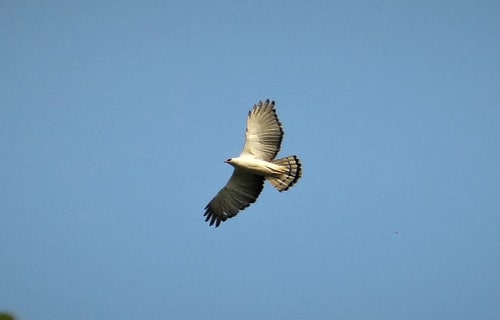
CCL: https://bit.ly/3am2z7z
Black-and-white hawk-eagle Distribution, Habitat, and Ecology
Despite not being widely known, the sincerely extraordinary Black-and-white hawk-eagle inhabits a fairly broad swathe of the world. That holds true due to the fact that the remarkable animal inhabits portions of both North America and South America.
Impressively, that native territory does not simply entail minor regions of the two continents. More precisely, the fascinating bird appears as far north as southern Mexico. However, its known endemic range also extends as far south as the country of Argentina.
However, within this wide range, it possesses highly specific requirements. That holds true since it only inhabits specific habitat types. These consist of consist of forests of any time. But, while it does inhabit highly humid and dense forests if it must, these are not preferred.
Furthermore, the impressive bird has even more decidedly precise preferences for where it makes its home. It only inhabits such regions that appear at lower altitudes, unless forced to relocate there. Furthermore, it prefers regions with close-packed canopies.
Like other raptors, the stunning Black-and-white hawk-eagle evolved to feed exclusively as a carnivore. Although it hunts opportunistically, it does, like most animals, have preferred prey. These primarily consist of various toads, small mammals and lizards.
However, one more unusual factor about its nature remains. To the surprise of many researchers, a large percentage of its diet also consists of various types of small birds. Although certain animals prey on its young in the nest, adults have few natural predators.

CCL: https://bit.ly/30qYpIs
6 Breathtaking Raptors
We fervently hope that you enjoyed this article about 6 Breathtaking Raptors. These birds never cease to amaze those who encounter them. To the minds of many people, these creatures represent some of the finest work of Nature, But, many of these marvelous species now find themselves in danger. It remains up to each of us to do all that we can to protect and preserve these 6 Breathtaking Raptors, as well as countless other wondrous species, for our posterity.
Check out our other articles on 6 Extraordinary North American Reptiles, Astounding Lizards of the World, Earth’s many Mesmerizing Cephalopods, 4 Fantastically Fascinating Fungi

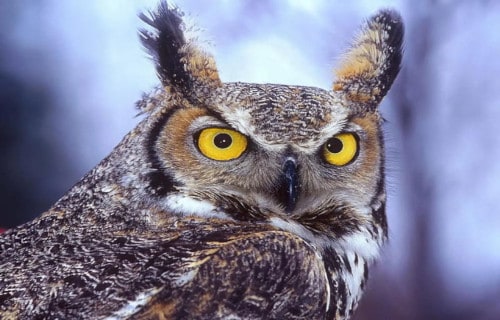
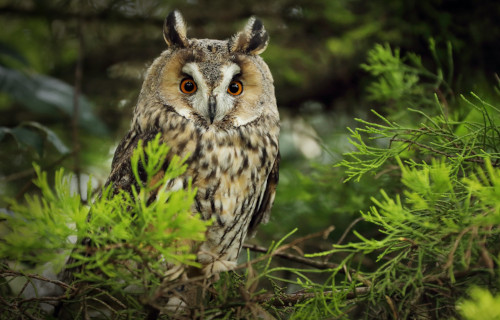
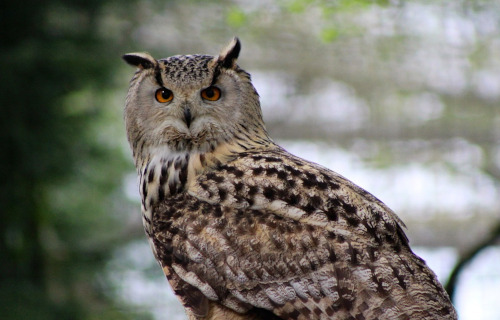

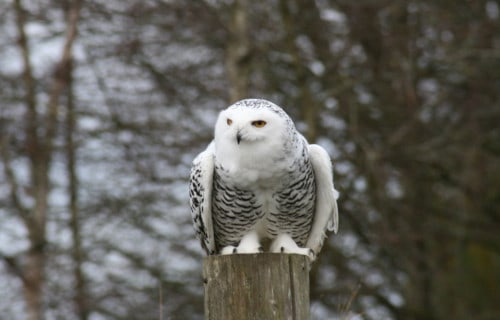
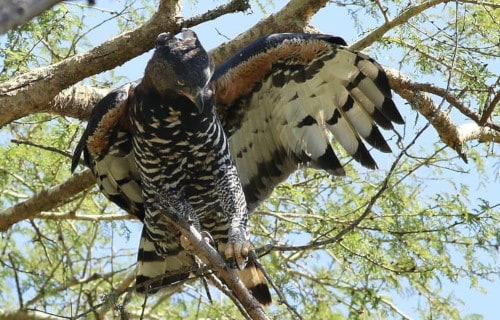
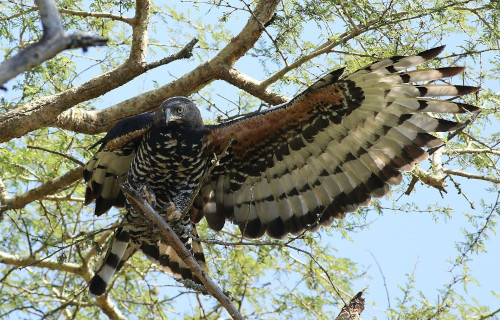
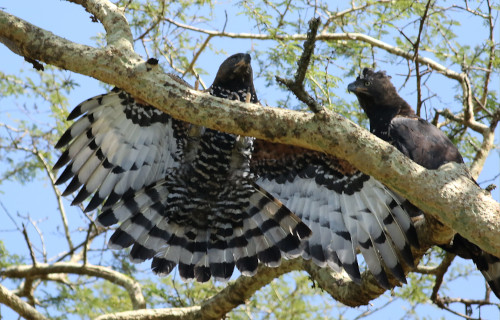









Leave a Reply